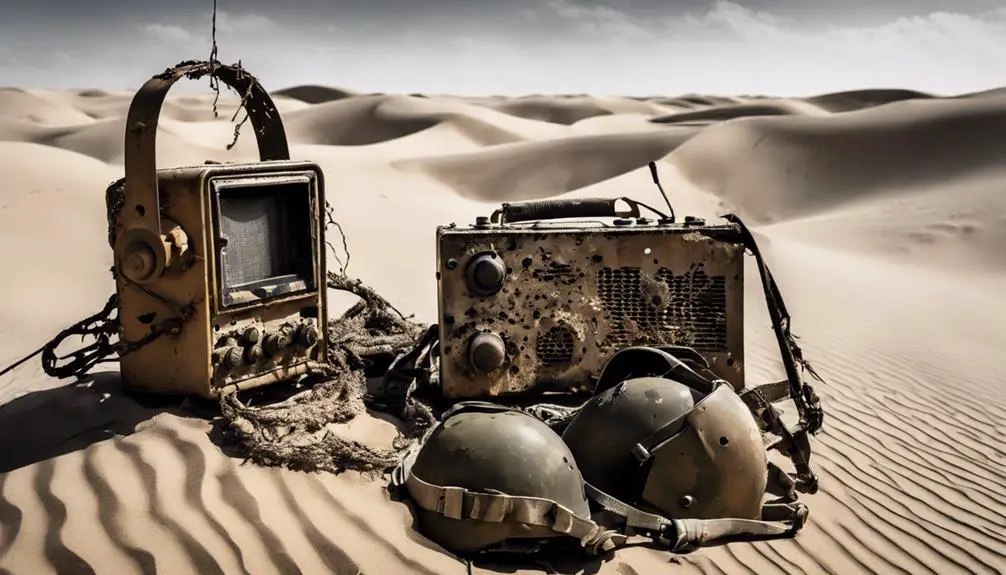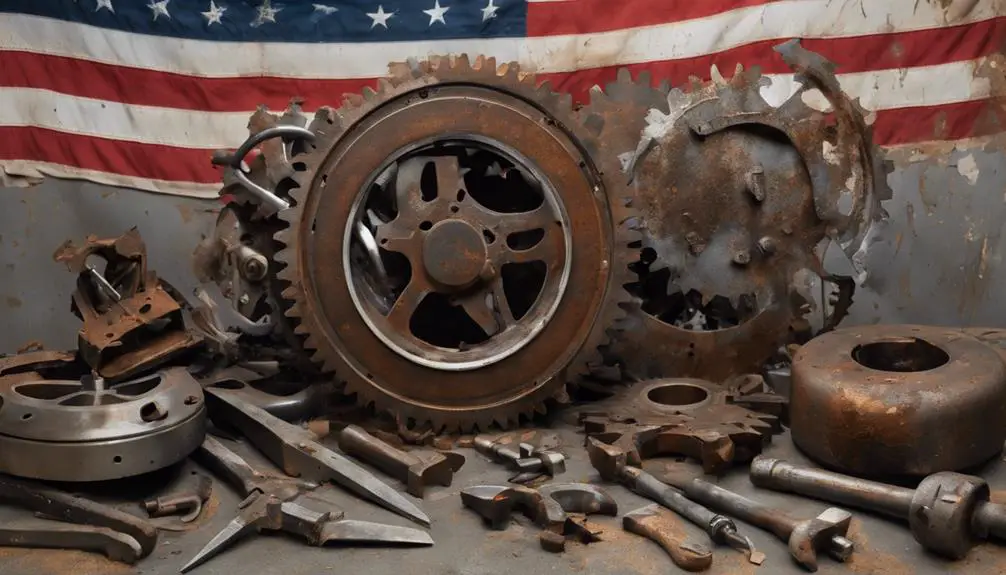When you're dealing with broken gear, you need to convey the status quickly. In the military, you'll hear phrases like 'broke-dick' to indicate equipment malfunction, or 'hosed' for catastrophic failures. If it's temporarily out of commission, it's 'down for maintenance.' Non-functional gear is 'non-mission capable' or 'NMC,' while an unflyable aircraft is 'deadlined.' These phrases aren't just essential for efficient communication. Want to know more about how these terms impact military operations?
Broke-Dick: The Universal Descriptor

When you're describing a broken or malfunctioning piece of equipment, 'broke-dick' is the go-to phrase that's universally understood across all branches of the military. It's a term that's been adopted as a common language, allowing troops to quickly convey the status of their gear. Whether you're a Marine, Soldier, Sailor, or Airman, 'broke-dick' instantly conveys that a piece of equipment is out of commission.
If you've got a broke-dick buddy, you know that their gear is malfunctioning, and it's time to find a replacement or get it fixed. It's not uncommon to hear the phrase 'broke-dick blues' when a critical piece of equipment fails, leaving troops feeling frustrated and stuck.
In the heat of the moment, there's no need to elaborate or explain – 'broke-dick' says it all. It's a phrase that's been battle-tested, and its meaning is crystal clear.
Hosed: When Equipment Fails
You're likely to hear 'hosed' when a critical system or piece of equipment fails catastrophically, leaving you scrambling to find a backup or fix the problem. This phrase is often used to describe an equipment malfunction that's beyond repair or requires extensive maintenance. When your gear is hosed, it's not just a minor technical difficulty – it's a showstopper.
Here are some scenarios where you might hear 'hosed':
- Communication breakdown: Your radio or satellite phone stops working, cutting off essential communication with your team or HQ.
- Vehicle failure: Your Humvee or tank breaks down, leaving you stranded in hostile territory.
- Weapon malfunction: Your rifle or pistol jams, leaving you defenseless in a firefight.
In each of these scenarios, 'hosed' is more than just a figure of speech – it's a call to action. You need to act fast to find a solution, whether that means calling in a repair team, finding a replacement, or improvising a fix on the fly.
Down for Maintenance

A critical system or piece of equipment is 'down for maintenance' when it's temporarily out of commission for repairs, refurbishment, or routine upkeep. This means you can't use it until it's fixed and back online. You might hear your superior say, 'The radar system is down for maintenance, so we need to rely on alternative methods for surveillance.'
You'll typically see a 'down for maintenance' notice when a system check reveals issues that require immediate attention. In such cases, you'll need to prioritize refurbishment plans to get the system back up and running. This might involve replacing faulty components, updating software, or performing routine cleaning and lubrication.
When a critical system is down, it can impact your unit's operational effectiveness. That's why it's crucial to prioritize maintenance and repairs to minimize downtime. By doing so, you'll ensure your equipment is functioning at efficient levels, and your team can perform their duties effectively.
Non-Mission Capable Items
In military jargon, non-mission capable (NMC) items refer to equipment or systems that can't perform their intended functions, rendering them unusable for their designated purposes. As a military personnel, you're likely to encounter NMC items more often than you'd like. This can be frustrating, especially when it hinders your team's ability to complete a mission.
Here are some common reasons why equipment becomes NMC:
- Supply shortage: When essential parts or components are unavailable, equipment can become NMC.
- Equipment redundancy: When multiple pieces of equipment are damaged or malfunctioning, it can lead to a shortage of functional equipment.
- Lack of maintenance: Neglecting regular maintenance can cause equipment to break down, making them NMC.
When you encounter NMC items, reporting them promptly is crucial to ensure they're repaired or replaced as soon as possible. This helps maintain operational readiness and prevents further delays or complications.
Deadlined: The Unflyable Aircraft

When an aircraft is designated as deadlined, it means the plane is unflyable due to mechanical issues, making it non-mission capable until repairs are made. You might hear pilots and maintenance crews tossing around this term, but what does it truly signify? Essentially, a deadlined aircraft is one that's grounded, waiting for spare parts or specialized repairs to get it back in the air.
These flightless wonders often find themselves in an aircraft graveyard, a designated area where they'll undergo repairs or await their fate. The term 'deadlined' is used to distinguish it from other types of maintenance or repairs. It's a clear indication that the aircraft isn't airworthy and needs attention before it can take to the skies again.
As a result, you'll often hear maintenance teams discussing the deadline for repairs, which is the timeframe in which the aircraft needs to be fixed and back in operation.
Out of Commission Pieces
You'll often come across equipment or machinery labeled as 'out of commission' during your time in the military, which means they're currently non-operational due to damage, malfunction, or maintenance. This phrase is commonly used to describe equipment that's no longer functional and requires repair or replacement.
In combat situations, battle damage can render critical equipment out of commission, putting lives at risk. In such cases, having spare parts readily available is crucial to facilitate quick repairs and get the equipment back in action.
Here are some key takeaways to remember:
- Equipment labeled 'out of commission' is non-operational and requires attention.
- Battle damage can render critical equipment unusable.
- Having spare parts on hand can expedite repairs and get equipment back online quickly.
Inoperable Gear Alert

If your gear is malfunctioning, a loud and clear 'inoperable gear alert' can mean the difference between mission success and catastrophic failure. You can't afford to have gear malfunctions go unnoticed, especially in high-stress situations. That's why establishing alert protocols is essential.
| Gear Malfunctions | Alert Protocols |
|---|---|
| Radio malfunction | Immediate alert to team lead |
| Weapon jam | Visual and verbal alerts to nearby personnel |
| Navigation system failure | Priority alert to command center |
| Communication device failure | Alert to entire unit via secondary channels |
| Critical system failure | Emergency alert to all personnel, evacuate area |
Don't let gear malfunctions catch you off guard. Establishing clear alert protocols can save lives and lead to mission success. Make sure you have a plan in place for when your gear fails. Remember, a loud and clear 'inoperable gear alert' can be the difference between success and failure. Stay vigilant and stay prepared.
Frequently Asked Questions
Can Broken Equipment Be Repaired in the Field?
When you're in the field, you can't afford to wait for repairs. Can broken equipment be fixed on the spot? It depends on the extent of the damage and your team's expertise.
Prioritize the most critical gear and focus on quick fixes that guarantee tactical readiness. Field expediency is key – you need to get back to operational status ASAP.
If it's beyond your team's capabilities, call in support or replace the equipment to maintain tactical prioritization.
What Is the Protocol for Reporting Broken Gear?
You're trudging through the battlefield, your gear weighing heavily on your shoulders. But what happens when that gear fails you?
When reporting broken gear, you'll need to follow strict protocols. First, conduct a thorough gear inspection to identify the issue. Then, fill out a detailed report, including the gear's serial number and a description of the problem.
Submit your report to your CO, who'll determine the next course of action. Remember, timely reporting guarantees prompt repair or replacement, getting you back in the fight quickly.
How Do I Differentiate Between Broken and Just Malfunctioning?
You're trying to figure out if your gear is truly broken or just malfunctioning. To differentiate, start with faulty diagnostics – identify the symptoms, then isolate the problem.
Next, perform equipment triage: assess the issue's severity and prioritize repairs. If it's a quick fix, you're good to go. If not, it's broken and needs replacement or extensive repair.
This process helps you determine the best course of action and get your gear back in working order.
Can I Use a Broken Item Temporarily Until Replacement?
You're wondering if you can MacGyver a broken item to limp along until a replacement arrives. The answer is a resounding 'maybe.'
In the heat of the moment, a battlefield workaround can be a lifesaver. But let's get real, a temporary fix is just that – temporary.
Don't rely on duct tape and prayers for too long, or you might find yourself in a world of trouble. Weigh the risks and rewards before deciding to push your broken gear to its limits.
Who Is Responsible for Fixing Broken Military Equipment?
When it comes to fixing broken military equipment, you'll typically rely on your Unit Armorer or Supply Sergeant. They're responsible for maintaining and repairing gear to keep your unit operational.
If the issue is beyond their expertise, they'll coordinate with higher-level maintenance teams or request replacement parts.
As a team member, you'll need to report any damaged equipment to these support specialists, so they can get it back in working order or arrange for a replacement.
Conclusion
You've heard the phrases thrown around in military circles, but what do they really mean? It's not just a coincidence that you've stumbled upon this article – it's a sign you need to know the lingo.
Now that you've got the lowdown on 'broke-dick,' 'hosed,' and 'deadlined,' you're officially in the know. Coincidence or not, being fluent in military slang just became a mission-critical skill.







